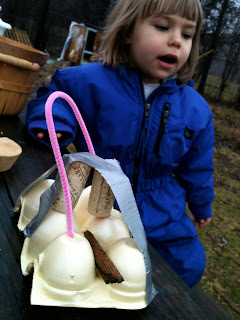We have been having a lot of fun in the snow these last couple of weeks! We're lucky to have a rich diversity of terrain, including a hill just the right size for toddler and preschool sledding. Many times, as I've observed all these little bodies making their way through the snow, I wonder at all their brains are learning. Whether the snow is light and fluffy, deep and stiff, or even icy on top, it provides a new challenge to their systems that is so good for growth. I wanted to share a few of the ways snow play is encouraging their development.
Physical development: Snow play provides a sensory experience for them through tactile, temperature, and taste. Walking in snow is not unlike walking in sand, the way it shifts beneath your feet with each step. This provides a new challenge to walking and running that helps them to become more agile on their feet. With each step, they are improving their strength as the snow slips back a little. They are also improving their balance, because with the unsteady surface, the brain and body must be always communicating to find the proper center of gravity.
Proprioceptive development: The proprioceptive system is what allows us to understand where our bodies begin and end in space. Each time these young ones take a step in the snow, they don't know exactly how far down their foot will go, before hitting firm ground. The proprioceptive system is also responsible for us understand how much force is needed in order to change in object. In the snow, the kids are constantly testing this out: making snowballs, digging ice, shoveling snow, building snowmen and other structures, pushing themselves down the hill on the sled, pulling up friends on the sled, etc.
Temporal Awareness: Footprints in the snow passively teach these children how far they have come. They can look back at their footprints, and understand the passage of space and time in a visual way.
Physics Lesson: Playing in the snow allows children to experiment with gravity. They build and lift and roll and throw. They feel the gradual-then-quick motion of starting at the top of the hill and sliding down on the sled. They learn how to pack snow in a ball, roll it into a bigger and bigger and BIGGER (have you seen our's?) ball. They try to lift it, push it, watch it roll down the hill. These are all Physics experiments.
Creative Problem Solving: Yes, there are always creative problem solving opportunities, but snow play provides some new ones: pulling each other in the sled, working together to build something or push something up the hill. Today it was how to get the sled up the hill when one friend doesn't want to get out of it.
Then, lest we forget to mention snow play is SNOW MUCH FUN!! Part of what is so great about it for the teachers is that the kids are busy and having a blast doing their very important work, growing their brains with every step and pat of their hands. This is a wonder to witness!






































